Bulk carrier
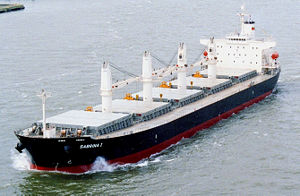 The Sabrina I is a modern Handymax bulk carrier. |
|
| Class overview | |
|---|---|
| Name: | Bulk carrier |
| Subclasses: | Handymax, Handysize, Panamax, Capesize |
| Built: | c. 1850–present |
| Active: | 6,225 vessels over 10,000 long tons of deadweight (DWT)[1] |
| General characteristics | |
| Type: | Cargo ship |
| Propulsion: | 2-stroke diesel engine and 1 propeller |
| Capacity: | up to 364,000 DWT |
| Notes: | Rear house, full hull, series of large hatches |
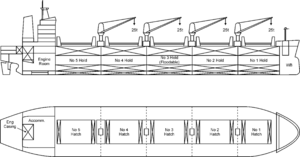 Plans of a geared Handymax bulker |
|
A bulk carrier, bulk freighter, or bulker is a merchant ship specially designed to transport unpackaged bulk cargo, such as grains, coal, ore, and cement in its cargo holds. Since the first specialized bulk carrier was built in 1852, economic forces have fueled the development of these ships, causing them to grow in size and sophistication. Today's bulkers are specially designed to maximize capacity, safety, efficiency, and to be able to withstand the rigors of their work.
Today, bulkers make up 40% of the world's merchant fleets and range in size from single-hold mini-bulkers to mammoth ore ships able to carry 365,000 metric tons of deadweight (DWT). A number of specialized designs exist: some can unload their own cargo, some depend on port facilities for unloading, and some even package the cargo as it is loaded. Over half of all bulkers have Greek, Japanese, or Chinese owners and more than a quarter are registered in Panama. Japan is the largest single builder of bulkers, and 82% of these ships were built in Asia.
A bulk carrier's crew participates in the loading and unloading of cargo, navigating the ship, and keeping its machinery and equipment properly maintained. Loading and unloading the cargo is difficult, dangerous, and can take up to 120 hours on larger ships. Crews can range in size from three people on the smallest ships to over 30 on the largest.
Bulk cargo can be very dense, corrosive, or abrasive, and presents safety problems: cargo shifting, spontaneous combustion, and cargo saturation can all doom a ship. The use of ships that are old and have corrosion problems has been linked to a spate of bulker sinkings in the 1990s, as have the bulker's large hatchways, important for efficient cargo handling. New international regulations have since been introduced to improve ship design and inspection, and to streamline the process of abandoning ship.
Contents |
Definition
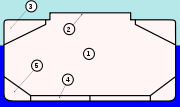
There are various ways to define the term bulk carrier. As of 1999, the International Convention for the Safety of Life at Sea defines a bulk carrier as "a ship constructed with a single deck, top side tanks and hopper side tanks in cargo spaces and intended to primarily carry dry cargo in bulk; an ore carrier; or a combination carrier."[2] However, most classification societies use a broader definition where a bulker is any ship that carries dry unpackaged goods.[3] Multipurpose cargo ships can carry bulk cargo, but can also carry other cargoes and are not specifically designed for bulk carriage. The term "dry bulk carrier" is used to distinguish bulkers from bulk liquid carriers such as oil, chemical, or liquefied petroleum gas carriers. Very small bulkers are almost indistinguishable from general cargo ships, and they are often classified based more on the ship's use than its design.
A number of abbreviations are used to describe bulkers. "OBO" describes a bulker which carries a combination of ore, bulk, and oil, and "O/O" is used for combination oil and ore carriers.[4] The terms "VLOC," "VLBC," "ULOC," and "ULBC" for very large and ultra large ore and bulk carriers were adapted from the supertanker designations very large crude carrier and ultra large crude carrier.[5]
History

Before specialized bulk carriers existed, shippers had two methods to move bulk goods by ship. In the first method, longshoremen loaded the cargo into sacks, stacked the sacks onto pallets, and put the pallets into the cargo hold with a crane.[6] The second method required the shipper to charter an entire ship and spend time and money to build plywood bins into the holds.[7] Then, to guide the cargo through the small hatches, wooden feeders and shifting boards had to be constructed.[7] These methods were slow and labor intensive. As with the container ship, the problem of efficient loading and unloading has driven the evolution of the bulk carrier.
Specialized bulk carriers began to appear as steam-powered ships became more popular.[6] The first steam ship recognized as a bulk carrier was the British coal carrier SS John Bowes in 1852.[8][9] She featured a metal hull, a steam engine, and a ballasting system which used seawater instead of sandbags.[8] These features helped her succeed in the competitive British coal market.[8] The first bulkers with diesel propulsion began to appear in 1911.[8][9]
Before World War II, the demand for bulk products was low—about 25 million tons for metal ores[10][11]—and most of this trade was coastal.[12] However, two defining characteristics of bulkers were already emerging: the double bottom, which was adopted in 1890,[8] and the triangular structure of the ballast tanks, which was introduced in 1905.[8] After World War II, an international bulk trade began to develop among industrialized nations, particularly between the European countries, the United States and Japan.[10] Due to the economics of this trade, bulkers became larger and more specialized.[13][11]
Categories
Size categories
| Major bulk carrier size categories | |||||
| Name | Size in DWT[14] |
Ships[15] | Traffic[16] | New price[17] |
Used price[18] |
|---|---|---|---|---|---|
| Handysize | 10,000 to 35,000 | 34% | 18% | $28M | $28M |
| Handymax | 35,000 to 55,000 | 37% | |||
| Panamax | 60,000 to 80,000 | 19% | 20% | $35M | $34M |
| Capesize | 80,000 and over | 10% | 62% | $59M | $68.4M |
Bulkers are segregated into six major size categories: small, handysize, handymax, panamax, capesize, and very large.[19] Very large bulk and ore carriers fall into the capesize category but are often considered separately.
Other categories occur in regional trade, such as Kamsarmax, with a maximum length of 229 meters, the maximum length that can load in the port of Kamsarin the Republic of Guinea.[20] Other terms such as Setouchmax, Dunkirkmax, and Newcastlemax also appear in regional trade.[19]
Mini-bulkers are prevalent in the category of small vessels with a capacity of under 10,000 DWT. Mini-bulkers carry from 500 to 2,500 tons, have a single hold, and are designed for river transport. They are often built to be able to pass under bridges and have small crews of three to eight people.
Handysize and Handymax ships are general purpose in nature.[3] These two segments represent 71% of all bulk carriers over 10,000 DWT and also have the highest rate of growth.[21] This is partly due to new regulations coming into effect which put greater constraints on the building of larger vessels.[21] Handymax ships are typically 150–200 m in length and 52,000 – 58,000 DWT with five cargo holds and four cranes.[3] These ships are also general purpose in nature.[3]
The size of a Panamax vessel is limited by the Panama canal's lock chambers, which can accommodate ships with a beam of up to 32.31 m, a length overall of up to 294.13 m, and a draft of up to 12.04 m.[22]
Capesize ships are too large to traverse the Suez or Panama canals and must round the Cape of Good Hope or Cape Horn to travel between oceans. Capesize bulkers are specialized: 93% of their cargo is iron ore and coal.[3] Very large ore carriers and very large bulk carriers are a subset of the capesize category reserved for vessels over 200,000 DWT.[19] Carriers of this size are almost always designed to carry iron ore.[19]
General types
| General Bulk Carrier Types | |
| Illustration | Description |
|---|---|
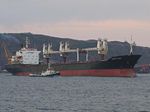 |
Geared bulk carriers feature a series of holds (from 5 for a 35,000 ton vessel to 9 for a 250,000 ton vessel)[23] covered by prominent hatch covers. They have cranes or derricks which allow them to discharge cargo in ports without shore-based equipment. This gives geared bulkers flexibility in the cargoes they can carry and the routes they can travel. (Photo: A typical geared handysize bulk carrier.) |
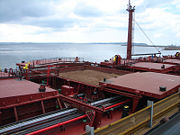 |
Combined carriers are designed to transport both liquid and dry bulk cargoes. If both are carried simultaneously, they are segregated in separate holds and tanks. Combined carriers require special design and are expensive. They were prevalent in the 1970s, but their numbers have dwindled since 1990. (Photo: The oil pipeline and dry bulk hold aboard the Maya.) |
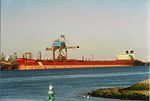 |
Gearless carriers are bulkers without cranes or conveyors. These ships depend on the shore-based equipment of the ports they visit for loading and unloading. Due to their large size, they can only dock at the largest and most advanced ports. The use of gearless bulkers avoids the costs of installing, operating, and maintaining cranes. (Photo:Berge Athen, a 225,000 ton gearless bulker.) |
| Self-dischargers are bulkers with conveyor belts which allow them to discharge their cargo quickly and efficiently. (Photo: The John B. Aird a self-discharger on the Great Lakes.) | |
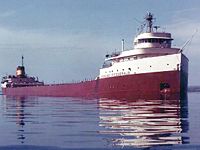 |
Lakers are the bulkers prominent on the Great Lakes, often identifiable by having a forward house which helps in transiting locks. Operating in fresh water, these ships suffer much less corrosion damage and have a much longer lifespan than saltwater ships.[24] As of 2005, there were 98 lakers of 10,000 DWT or over.[25] (Photo: Edmund Fitzgerald, a Great Lakes bulker.) |
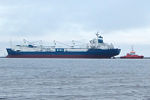 |
BIBO or "Bulk In, Bags Out" bulkers are equipped to bag cargo as it is unloaded. The CHL Innovator, shown in the photo, is a BIBO bulker. In one hour, this ship can unload 300 tons of bulk sugar and package it into 50 kg sacks.[26] |
Fleet characteristics

The world's bulk transport has reached immense proportions: in 2005, 1.7 billion metric tons of coal, iron ore, grain, bauxite, and phosphate was transported by ship.[28] Today, the world's bulker fleet includes 6,225 ships of over 10,000 DWT, and represent 40% of all ships in terms of tonnage and 39.4% in terms of vessels.[29] Including smaller ships, bulkers have a total combined capacity of almost 346 million DWT.[30] Combined carriers are a very small portion of the fleet, representing less than 3% of this capacity.[30] The bulkers of the Great Lakes, with 98 ships of 3.2 million total DWT, form another small fraction of the total fleet.[29]
As of 2005, the average bulker was just over 13 years old.[31] About 41% of all bulkers were less than ten years old, 33% were over twenty years old, and the remaining 27% were between ten and twenty years of age.[31] All of the 98 bulkers registered in the Great Lakes trade are over 20 years old.[32]

Flag states
As of 2005, the United States Maritime Administration counted 6,225 bulkers of 10,000 DWT or greater worldwide.[1] More bulkers are registered in Panama, with 1,703 ships, than any four other flag states combined.[1] In terms of the number of bulk carriers registered, the top five flag states also include Hong Kong with 492 ships, Malta (435), Cyprus (373), and China (371).[1] Panama also dominates bulker registration in terms of deadweight tonnage. Positions two through five are held by Hong Kong, Greece, Malta, and Cyprus.[1]
Largest fleets
Greece, Japan, and China are the top three owners of bulk carriers, with 1,326, 1,041, and 979 vessels respectively.[34] These three nations account for over 53% of the world's fleet.[34]
Several companies have large private bulker fleets. The multinational company Gearbulk Holding Ltd. has over 7 bulkers.[35] The Fednav Group in Canada operates a fleet of over 80 bulkers, including two designed to work in Arctic ice.[36] Croatia's Atlantska Plovidba d.d. has a fleet of 14 bulkers.[37] The H. Vogemann Group in Hamburg, Germany operates a fleet of 19 bulkers.[38] Portline in Portugal, owns 10 bulkers.[39] Dampskibsselskabet Torm in Denmark and Elcano in Spain also own notable bulker fleets.[40] Other companies specialize in mini-bulker operations: England's Stephenson Clarke Shipping Limited owns a fleet of eight mini-bulkers and five small Handysize bulkers,[41] and Cornships Management and Agency Inc. in Turkey owns a fleet of seven mini-bulkers.[42]
Builders
Asian companies dominate the construction of bulk carriers. Of the world's 6,225 bulkers, almost 62% were built in Japan[43] by shipyards such as Oshima Shipbuilding and Sanoyas Hishino Meisho.[3] South Korea, with notable shipyards Daewoo and Hyundai Heavy Industries,[3] ranked second among builders, with 643 ships. The People's Republic of China, with large shipyards such as Dalian, Chengxi, and Shanghai Waigaoqiao, ranked third, with 509 ships.[43] Taiwan, with shipyards such as China Shipbuilding Corporation,[3] ranked fourth, accounting for 129 ships.[43] Shipyards in these top four countries built over 82% of the bulkers afloat.[43]
Freight charges
Several factors affect the cost to move a bulk cargo by ship. The bulk freight market is very volatile, and it fluctuates, along with the type of cargo, the ship's size, and the route traveled all affect the final price. Moving a capesize load of coal from South America to Europe cost anywhere from $15 to $25 per ton in 2005.[44] Hauling a panamax-sized load of aggregate materials from the Gulf of Mexico to Japan that year could cost as little as $40 per ton to as much as $70 per ton.[44]
Some shippers choose instead to charter a ship, paying a daily rate instead of a set price per ton.[44] In 2005, the average daily rate for a Handymax ship varied between $18,000 – $30,000.[44] A Panamax ship could be chartered for $20,000 – $50,000 per day, and a Capesize for $40,000 – $70,000 per day.[44]
Ship breaking
Generally, ships are removed from the fleet go through a process known as ship breaking or scrapping.[45] Ship-owners and buyers negotiate scrap prices based on factors such as the ship's empty weight (called light ton displacement or LDT) and prices in the scrap metal market.[46] In 1998, almost 700 ships were scrapped in places like Alang, India and Chittagong, Bangladesh.[45] Half a million deadweight tons of worth of bulk carriers were scrapped in 2004, accounting for 4.7% of the year's scrapping.[44] That year, bulkers fetched particularly high scrap prices, between $340 and $350 per LDT.[44]
Operation
Crew
| Captain/Master | ||
| Deck department |
Engine department |
Steward's department |
|---|---|---|
|
1 -Chief Officer |
1 -Chief Engineer |
1-Chief Steward |
The crew on a bulker typically consists of 20 to 30 people, though smaller ships can be handled by 8. The crew includes the captain or master, the deck department, the engineering department, and the steward's department. The practice of taking passengers aboard cargo ships, once almost universal, is very rare today and almost non-existent on bulkers.[47]
During the 1990s, bulkers were involved in an alarming number of shipwrecks. This led ship-owners to commission a study seeking to explain the effect of various factors on the crew's effectiveness and competence.[48] The study showed that crew performance aboard bulk carriers was the lowest of all groups studied.[48] Among bulker crews, the best performance was found aboard younger and larger ships.[48] Crews on better-maintained ships performed better, as did crews on ships where fewer languages were spoken.[48]
Fewer deck officers are employed on bulkers than on similarly sized ships of other types.[48] A mini-bulker carries two to three deck officers, while larger Handysize and Capesize bulkers carry four.[48] Liquid natural gas tankers of the same size have an additional deck officer and unlicensed mariner.[48]
Voyages
A bulker's voyages are determined by market forces; routes and cargoes often vary. A ship may engage in the grain trade during the harvest season and later move on to carry other cargoes or work on a different route. Aboard a coastal carrier in the tramp trade, the crew will often not know the next port of call until the cargo is fully loaded.
Because bulk cargo is so difficult to discharge, bulkers spend more time in port than other ships. A study of mini-bulkers found that it takes, on average, twice as much time to unload a ship as it does to load it.[48] A mini-bulker spends 55 hours at a time in port, compared to 35 hours for a lumber carrier of similar size.[48] This time in port increases to 74 hours for Handymax and 120 hours for Panamax vessels.[48] Compared with the 12-hour turnarounds common for container ships, 15-hour turnarounds for car carriers, and 26-hour turnarounds for large tankers, bulker crews have more opportunities to spend time ashore.[48]
Loading and unloading
Loading and unloading a bulker is time-consuming and dangerous. The process is planned by the ship's captain, often with assistance from the chief mate. International regulations require that the captain and terminal master agree on a detailed plan before operations begin.[49] Deck officers and stevedores oversee the operations. Occasionally loading errors are made that cause a ship to capsize or break in half at the pier.[50]
The loading method used depends on both the cargo and the equipment available on the ship and on the dock. In the least advanced ports, cargo can be loaded with shovels or bags poured from the hatch cover. This system is being replaced with faster, less labor-intensive methods.[51] Double-articulation cranes, which can load at a rate of 1,000 tons per hour, represent a widely used method,[51] and the use of shore-based gantry cranes, reaching 2,000 tons per hour, is growing.[51] A crane's discharge rate is limited by the bucket's capacity (from 6 to 40 tons) and by the speed at which the crane can take a load, deposit it at the terminal, and to return to take the next. For modern gantry cranes, the total time of the grab-deposit-return cycle is about 50 seconds.[3]
Conveyor belts offer a very efficient method of loading, with standard loading rates varying between 100 and 700 tons per hour, although the most advanced ports can offer rates of 16,000 tons per hour.[52][51] Start-up and shutdown procedures with conveyor belts, though, are complicated and require time to carry out.[52] Self-discharging ships use conveyor belts with load rates of around 1,000 tons per hour.[51]
Once the cargo is discharged, the crew begins to clean the holds. This is particularly important if the next cargo is of a different type.[53] The immense size of cargo holds and the tendency of cargoes to be physically irritating add to the difficulty of cleaning the holds. When the holds are clean, the process of loading begins.
It is crucial to keep the cargo level during loading in order to maintain stability.[54] As the hold is filled, machines such as excavators and bulldozers are often used to keep the cargo in check. Leveling is particularly important when the hold is only partly full, since cargo is more likely to shift.[55] Extra precautions are taken, such as adding longitudinal divisions and securing wood atop the cargo.[6] If a hold is full, a technique called tomming is used,[54] which involves digging out a 6 feet (2 m) hole below the hatch cover and filling it bagged cargo or weights.[54]
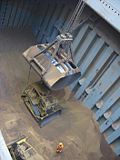 |
 |
 |
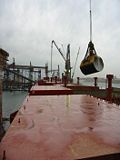 |
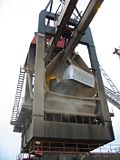 |
| 1. A bulldozer is loaded into the hold. | 2. The bulldozer pushes cargo to the center of the hold. | 3. The gantry crane picks up the cargo. | 4. The gantry crane removes the cargo from the ship. | 5. The gantry crane moves the cargo to a bin on the pier. |
| Photos courtesy of Danny Cornelissen of portpictures.nl. | ||||
Architecture


A bulk carrier's design is largely defined by the cargo it will carry. The cargo's density, also known as its stowage factor, is the key factor. Densities for common bulk cargoes vary from 0.6 tons per cubic meter for light grains to 3 tons per cubic meter for iron ore.[3]
The overall cargo weight is the limiting factor in the design of an ore carrier, since the cargo is so dense. Coal carriers, on the other hand, are limited by overall volume, since most bulkers can be completely filled with coal before reaching their maximum draft.[3]
For a given tonnage, the second factor which governs the ship's dimensions is the size of the ports and waterways it will travel to. For example, a vessel that will pass the Panama Canal will be limited in its beam and draft. For most designs, the ratio of length-to-width ranges between 5 and 7, with an average of 6.2.[3] The ratio of length-to-height will be between 11 and 12.[3]
Machinery
The engine room on a bulker is usually near the stern, under the house and above the fuel tanks. Larger bulkers, from Handymax up, have a two-stroke diesel engine which directly moves a single propeller. An alternator is coupled directly with the propeller shaft, and an auxiliary generator is used.[3] On the smallest bulkers, one or two four-stroke diesels are used, and coupled with the propeller via a gear box.[3] The average design ship speed for bulkers of Handysize and above is between 13.5 and 15 knots (28 km/h).[19] The propeller speed is relatively low, at about 90 revolutions per minute.[3]
As a result of the 1973 oil crisis, the 1979 energy crisis, and the resulting rise in oil prices, experimental designs using coal to fuel ships were tested in the late 1970s and early 1980s. The Australian company New Lines constructed a 74,700-ton coal-burner called the River Boyne.[56] The ship was marginally effective, and its steam engine was able to generate a shaft-power of 19,000 horsepower (14,000 kW).[56] This strategy gave an interesting advantage to carriers of bauxite and similar fuel cargoes, but suffered from poor engine yield, maintenance problems, and high initial costs.[56]
Hatches
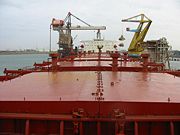
A hatch or hatchway is the opening at the top of a cargo hold. The mechanical devices which allow hatches to be opened and closed are called hatch covers. In general, hatch covers are between 45% and 60% of the ship's breadth, or beam, and 57% to 67% of the length of the holds.[3] To efficiently load and unload cargo, hatches must be large, but large hatches present structural problems. Hull stress is concentrated around the edges of the hatches, and these areas must be reinforced.[57] Often, hatch areas are reinforced by locally increasing the scantlings or by adding structural members called stiffeners. Both of these options have the undesired effect of adding weight to the ship.
As recently as the 1950s, hatches had wooden covers that would be broken apart and rebuilt by hand, rather than opened and closed.[58] Newer vessels have hydraulic-operated metal hatch covers that can often be operated by one person.[59] Hatch covers can slide forwards, backwards, or to the side, lift up or fold up. It is essential that the hatch covers be watertight: unsealed hatches lead to accidental cargo hold flooding, which has caused many bulkers to sink.[60]
Regulations regarding hatch covers have evolved since the investigation following the loss of the MV Derbyshire.[61] The Load Line Conference of 1966 imposed a requirement that hatch covers be able to withstand load of 1.74 tons/m² due to sea water, and a minimum scantling of 6 mm for the tops of the hatch covers. The International Association of Classification Societies then increased this strength standard by creating its Unified Requirement S21[62] in 1998. This standard requires that the pressure due to sea water be calculated as a function of freeboard and speed, especially for hatch covers located on the forward portion of the ship.[62]
Hull
Bulkers are designed to be easy to build and to store cargo efficiently. To facilitate construction, bulkers are built with a single hull curvature.[3] Also, while a bulbous bow allows a ship to move more efficiently through the water, designers lean towards simple vertical bows on larger ships.[3] Full hulls, with large block coefficients, are almost universal, and as a result, bulkers are inherently slow.[3] This is offset by their efficiency. Comparing a ship's carrying capacity in terms of deadweight tonnage to its weight when empty is one way to measure its efficiency.[3] A small Handymax ship can carry five times its weight.[3] In larger designs, this efficiency is even more pronounced: Capesize vessels can carry over eight times their weight.[3]
Bulkers have a cross-section typical of most merchant ships. The upper and lower corners of the hold are used as ballast tanks, as is the double bottom area. The corner tanks are reinforced and serve another purpose besides controlling the ship's trim. Designers choose the angle of the corner tanks to be less than that of the angle of repose of the anticipated cargoes.[12] This greatly reduces side-to-side movement, or "shifting," of cargo which can endanger the ship.[12]
The double bottoms are also subject to design constraints. The primary concern is that they be high enough to allow the passage of pipes and cables. These areas must also be roomy enough to allow people safe access to perform surveys and maintenance. On the other hand, concerns of excess weight and wasted volume keep the double bottoms very tight spaces.
Bulker hulls are made of steel, usually mild steel.[63] Some manufacturers have preferred high-tensile steel recently in order to reduce the tare weight.[64] However, the use of high-tensile steel for longitudinal and transverse reinforcements can reduce the hull's rigidity and resistance to corrosion.[12] Forged steel is used for some ship parts, such as the propeller shaft support.[3] Transverse partitions are made of corrugated iron, reinforced at the bottom and at connections.[3] The construction of bulker hulls using a concrete-steel sandwich has been investigated.[65]
Double hulls have become popular in the past ten years.[3] Designing a vessel with double sides adds primarily to its breadth, since bulkers are already required to have double bottoms.[66] One of the advantages of the double hull is to make room to place all the structural elements in the sides, removing them from the holds.[67] This increases the volume of the holds, and simplifies their structure which helps in loading, unloading, and cleaning.[68] Double sides also improve a ship's capacity for ballasting, which is useful when carrying light goods: the ship may have to increase its draft for stability or seakeeping reasons, which is done by adding ballast water.
A recent design, called Hy-Con, seeks to combine the strengths of single-hull and double-hull construction. Short for Hybrid Configuration, this design doubles the forward-most and rear-most holds and leaves the others single-hulled.[69] This approach increases the ship's solidity at key points, while reducing the overall tare weight.[70]
Since the adoption of double hull has been more of an economic than a purely architectural decision, some argue that double-sided ships receive less comprehensive surveys and suffer more from hidden corrosion.[71] In spite of opposition, double hulls became a requirement for Panamax and Capesize vessels in 2005.[72]
Freighters are in continual danger of "breaking their back"[73] and thus longitudinal strength is a primary architectural concern. A naval architect uses the correlation between longitudinal strength and a set of hull thicknesses called scantlings to manage problems of longitudinal strength and stresses. A ship's hull is composed of individual parts called members.[73] The set of dimensions of these members is called the ship's scantlings.[73] Naval architects calculate the stresses a ship can be expected to be subjected to, add in safety factors, and then can calculate the required scantlings.[73]
These analyses are conducted when traveling empty, loading and unloading, when partially and fully loaded, and under conditions of temporary overloading.[3] Places subject to the largest stresses are studied carefully, such as hold-bottoms, hatch-covers, bulkheads between holds, and the bottoms of ballast tanks.[3] Great Lakes bulkers also must be designed to withstand springing, or developing resonance with the waves, which can cause fatigue fractures.[74]
Since April 1, 2006, the International Association of Classification Societies has adopted the Common Structural Rules. The rules apply to bulkers more than 90 meters in length and require that scantlings' calculations take into account items such as the effect of corrosion, the harsh conditions often found in the North Atlantic, and dynamic stresses during loading. The rules also establish margins for corrosion, from 0.5 to 0.9 mm.[75]
Safety
The 1980s and 1990s were a very unsafe time for bulk carriers. Many bulkers sank during this time, 99 were lost between 1990 and 1997 alone.[10] Most of these sinkings were sudden and quick, making it impossible for the crew to escape: more than 650 sailors were lost during this same period.[10] Due partly to the sinking of the MV Derbyshire, a series of international safety resolutions regarding bulkers were adopted during the 1990s.[23]
Stability problems
Cargo shifting poses a great danger for bulkers. The problem is even more pronounced with grain cargoes, since grain settles during a voyage and creates extra space between the top of the cargo and the top of the hold.[6] Cargo is then free to move from one side of the ship to the other as the ship rolls. This can cause the ship to list, which, in turn, causes more cargo to shift. This kind of chain reaction can capsize a bulker very quickly.[6]
The 1960 SOLAS Convention sought to control this sort of problem.[76] These regulations required the upper ballast tanks designed in a manner to prevent shifting. They also required cargoes to be leveled, or trimmed, using excavators in the holds.[77] The practice of trimming reduces the amount of the cargo's surface area in contact with air[78] which has a useful side-effect: reducing the chances of spontaneous combustion in cargoes such as coal, iron, and metal shavings.[78]
Another sort of risk that can affect dry cargoes, is absorption of ambient moisture.[79] When very fine concretes and aggregates mix with water, the mud created at the bottom of the hold shifts easily and can produce a free surface effect.[79] The only way to control these risks is by good ventilation practices and careful monitoring for the presence of water.[79]
Structural problems

In 1990 alone, 20 bulk carriers sank, taking with them 94 crewmen. In 1991, 24 bulkers sank, killing 154.[80] This level of loss focused attention on the safety aspects of bulk carriers, and a great deal was learned. The American Bureau of Shipping concluded that the losses were "directly traceable to failure of the cargo hold structure"[24] and Lloyd's Register of Shipping added that the hull sides could not withstand "the combination of local corrosion, fatigue cracking and operational damage."[80]
The accident studies showed a clear pattern:[60]
- Sea water enters the forward hatch, due to a large wave, a poor seal, corrosion, etc.[60]
- The extra water weight in hold number one compromises the partition to hold number two,[60]
- Water enters hold number two and alters the trim so much that more water enters the holds[60]
- With two holds rapidly filling with water, the bow submerges and the ship quickly sinks, leaving little time for the crew to react.[60]
Previous practices had required ships to withstand the flooding of a single forward hold, but did not guard against situations where two holds would flood. The case where two after (rear) holds are flooded is no better, because the engine room is quickly flooded, leaving the ship without propulsion. If two holds in the middle of the ship are flooded, the stress on the hull can become so great that the ship snaps in two.

Other contributing factors were identified:
- Most shipwrecks involved ships over 20 years in age. A glut of ships of this age occurred in the 1980s, caused by an overestimate of the growth of international trade. Rather than replace them prematurely, shipping companies were compelled on cost grounds to keep their aging vessels in service.[6]
- Corrosion, due to a lack of maintenance, affected the seals of the hatch covers and the strength of the bulkheads which separate holds. The corrosion is difficult to detect due do the immense size of the surfaces involved.[81][82]
- Advanced methods of loading were not foreseen when the ships were designed. While the new processes are more efficient, loading is more difficult to control (it can take over an hour just to halt the operation), occasionally resulting in overloading the ship. These unexpected shocks, over time, can damage the hull's structural integrity. [52]
- Recent use of high-tensile steel in construction enables buildings to retain the similar strength with less material and weight. However, because it is thinner than regular steel, HT steel can corrode though more easily, plus it can develop metal fatigue in choppy seas.[74]
- According to Lloyd's Register, a principal cause was the attitude of ship-owners, who sent ships with known problems to sea.[83]
The new rules adopted in the 1997 annexes to the SOLAS convention focused on problems such as reinforcing bulkheads and the longitudinal frame, more stringent inspections (with a particular focus on corrosion) and routine in-port inspections.[6] The 1997 additions also required bulkers with restrictions (for instance, forbidden from carrying certain types of cargoes) to mark their hulls with large, easy-to-see triangles.[84]
Crew safety

Since December 2004, Panamax and Capesize bulkers have been required to carry free-fall lifeboats located on the stern, behind the house.[6] This arrangement allows the crew to abandon ship quickly in case of a catastrophic emergency.[85] One argument against the use of free-fall lifeboats is that the evacuees require "some degree of physical mobility, even fitness" to enter and launch the boat.[86] Also, injuries have occurred during launches, for example, in the case of incorrectly secured safety belts.[86]
In December 2002, Chapter XII of the SOLAS convention was amended to require the installation of high-level water alarms and monitoring systems on all bulkers. This safety measure quickly alerts watch standers on the bridge and in the engine room in case of flooding in the holds.[6] In cases of catastrophic flooding, these detectors could speed the process of abandoning ship. Nevertheless, every two months, somewhere in the worlds oceans, an average of one bulk carrier goes down with total loss of life.
See also
- MV Bright Field
- MV Lake Illawarra
- MV Flare
- Sygna (shipwreck)
- SS Edmund Fitzgerald
Notes
- ↑ 1.0 1.1 1.2 1.3 1.4 Office of Data and Economic Analysis, 2006:6.
- ↑ "Maritime Safety Committee's 70th Session, January 1999". American Bureau of Shipping. Retrieved on 2007-04-09.
- ↑ 3.00 3.01 3.02 3.03 3.04 3.05 3.06 3.07 3.08 3.09 3.10 3.11 3.12 3.13 3.14 3.15 3.16 3.17 3.18 3.19 3.20 3.21 3.22 3.23 3.24 3.25 3.26 3.27 Lamb, 2003.
- ↑ "Maritime Glossary". The Transportation Institute. Retrieved on 2008-05-06.
- ↑ "Acronyms and Abbreviations". The Nautical Institute. Retrieved on 2007-04-12.
- ↑ 6.0 6.1 6.2 6.3 6.4 6.5 6.6 6.7 6.8 "Bulk Carrier - Improving Cargo Safety". United Nations Atlas of the Oceans. Retrieved on 2007-04-09.
- ↑ 7.0 7.1 Hayler, 2003:5–13.
- ↑ 8.0 8.1 8.2 8.3 8.4 8.5 Bruno-Stéphane Duron, Le Transport maritime des céréales
 DOC, mémoire de DESS, 1999.
DOC, mémoire de DESS, 1999. - ↑ 9.0 9.1 "Ship". 1911 Encoclopedia Britannica. Retrieved on 2007-04-12.
- ↑ 10.0 10.1 10.2 10.3 International Maritime Organization, 1999:1.
- ↑ 11.0 11.1 "Bulk Carriers". United Nations Ocean Atlas. Retrieved on 2007-04-12.
- ↑ 12.0 12.1 12.2 12.3 "IMO and the safety of bulk carriers" (PDF). International Maritime Organization. Retrieved on 2007-04-09.
- ↑ International Maritime Organization, 1999: 1, 2.
- ↑ Ranges vary slightly. MAN Diesel Group 2005, p.4. UNCTAD 2006, p. xii.
- ↑ From Lamb, 2003 and the 2005 CIA World Factbook. See also graph and table at Wikipedia commons.
- ↑ From Lamb, 2003. This is measured in terms of the tonnage of cargo carried multiplied by the distance traveled, and could be expressed in terms of (miles x tons), for example.
- ↑ UNCTAD 2006, p. 41. Price for new vessel $M in 2005.
- ↑ UNCTAD 2006, p. 42. Five year old ship in $M in 2005.
- ↑ 19.0 19.1 19.2 19.3 19.4 MAN Diesel Group, 2005, p. 3-4.
- ↑ "Kamsarmax 82BC". Tsuneishi Corp.. Retrieved on 2007-04-12.
- ↑ 21.0 21.1 "Handysize re-vamp: the next move in bulk carriers?". The Naval Architect. January 2006.
- ↑ Autoridad del Canal de Panamá 2005, pp. 11 – 12.
- ↑ 23.0 23.1 "Improving the safety of bulk carriers" (PDF). International Maritime Organization. Retrieved on 2007-04-09.
- ↑ 24.0 24.1 International Maritime Organization, 1999:6.
- ↑ Office of Data and Economic Analysis, 2006:1.
- ↑ "CHL INNOVATOR". Port of Rijeka, Croatia. Retrieved on 2008-05-05.
- ↑ Lloyd's Register World Fleet Statistics Tables. London: Lloyd's. 2000. http://www.lrfairplay.com.
- ↑ UNCTAD 2006, p.11.
- ↑ 29.0 29.1 Office of Data and Economic Analysis, 2006:1.
- ↑ 30.0 30.1 UNCTAD 2006, p. 21.
- ↑ 31.0 31.1 UNCTAD 2006, p. 23.
- ↑ Office of Data and Economic Analysis, 2006:2.
- ↑ "The CIA World Factbook, 2005". cia.gov. Retrieved on 2007-04-09.
- ↑ 34.0 34.1 Office of Data and Economic Analysis, 2006:4.
- ↑ Gearbulk (2008). "About Us". Gearbulk Holding Limited. Retrieved on 2008-04-22.
- ↑ Fednav Group (2007). "Fleet Owned". Fednav Group. Retrieved on 2008-04-21. and Fednav Group (2007). "Fleet Chartered". Fednav Group. Retrieved on 2008-04-21.
- ↑ "Atlantska Plovidba Fleet". Atlantska Plovidba d.d. Dubrovnik.. Retrieved on 2007-04-15.
- ↑ H. Vogemann Group (2007). "Fleet List" (PDF). H. Vogemann Group. Retrieved on 2008-05-01.
- ↑ "Portline Frota". PORTLINE Transportes Marítimos Internacionais, S.A.. Retrieved on 2007-04-15.
- ↑ According to description of the main ship-owners, from the French Marine-Marchande website.
- ↑ "Stephenson Clarke Fleet". Stephenson Clarke Shipping Ltd. Retrieved on 2007-04-15.
- ↑ "The Cornships Fleet". Cornships Management & Agency Inc.. Retrieved on 2007-04-15.
- ↑ 43.0 43.1 43.2 43.3 Office of Data and Economic Analysis, 2006:5.
- ↑ 44.0 44.1 44.2 44.3 44.4 44.5 44.6 UNCTAD 2005.
- ↑ 45.0 45.1 Bailey, Paul J. (2000). "Is there a decent way to break up ships?". Sectoral Activities Programme. International Labour Organization. Retrieved on 2007-05-29.
- ↑ Maritime Transport Coordination Platform (November 2006). "3: The London Tonnage Convention" (pdf). Tonnage Measurement Study. MTCP Work Package 2.1, Quality and Efficiency. Bremen/Brussels. pp. 3.3. http://ec.europa.eu/transport/maritime/studies/doc/2006_11_tonnage_measurement_study.pdf. Retrieved on 2007-05-29.
- ↑ Some companies specialize in providing cruises on various kinds of freighters, for example Freighter World Cruises.
- ↑ 48.00 48.01 48.02 48.03 48.04 48.05 48.06 48.07 48.08 48.09 48.10 Lane, Tony (2001). Bulk Carrier Crews; Competence, Crew composition & Voyage Cycles. Cardiff University.
- ↑ "MSC Circular 947: Safe Loading and Unloading of Bulk Carriers" (PDF). International Maritime Organization. Retrieved on 2007-04-15.
- ↑ George, 2005:245.
- ↑ 51.0 51.1 51.2 51.3 51.4 Packard, William V. (1985). Sea-trading. Fairplay Publications.
- ↑ 52.0 52.1 52.2 International Maritime Organization, 1999:7.
- ↑ Hayler, 2003:5–11.
- ↑ 54.0 54.1 54.2 Hayler, 2003:5–13.
- ↑ George, 2005:341, 344.
- ↑ 56.0 56.1 56.2 Ewart, W.D. (1984). Bulk Carriers. Fairplay Publications Ltd,. ISBN 0-905045-42-4.
- ↑ International Maritime Organization, 1999:7.
- ↑ Hayler, 2003:5–9.
- ↑ Hayler, 2003:5–11.
- ↑ 60.0 60.1 60.2 60.3 60.4 60.5 "Improving the safety of bulk carriers" (PDF). International Maritime Organization. Retrieved on 2007-04-09.
- ↑ Byrne, David (10). "Hatch Covers on Bulk Carriers: The Effect on Procurement Costs of Changes in Design Pressure"..
- ↑ 62.0 62.1 International Association of Classification Societies 2007, p. 21-1.
- ↑ George, 2005:221.
- ↑ International Maritime Organization, 1999:8.
- ↑ "Concrete sandwiches: structural strength and safety for bulk carriers". The Naval Architect. February 2005.
- ↑ "New IMO bulk carrier regulations enter into force on 1 July 1999". International Maritime Organization. Retrieved on 2007-04-10.
- ↑ "NG-Bulk20: a new Turkish double-skin bulker design". The Naval Architect. November 2005.
- ↑ Det Norske Veritas (28). "Oshima looks ahead". Retrieved on 2007-04-15.
- ↑ "Oshima Hy-Con Bulker". Oshima Shipbuilding Co., Ltd.. Retrieved on 2007-04-14.
- ↑ ""Ultra Handymax" Semi-Double Hull Handymax Bulk Carrier". Oshima Shipbuilding Co., Ltd.. Retrieved on 2007-04-10.
- ↑ "Double-Hull Tanker Legislation: An Assessment of the Oil Pollution Act of 1990 (1998)". Marine Board Commission on Engineering and Technical Systems. Retrieved on 2007-04-10.
- ↑ "Double-skin bulkers: paradise or problem?". The Naval Architect. May 2003.
- ↑ 73.0 73.1 73.2 73.3 George, 2005:217.
- ↑ 74.0 74.1 International Maritime Organization, 1999:8.
- ↑ "Implications of commons structural rules". The Naval Architect. March 2006.
- ↑ International Maritime Organization, 1999:2.
- ↑ International Maritime Organization, 1999:1,2.
- ↑ 78.0 78.1 International Maritime Organization, 1999:4.
- ↑ 79.0 79.1 79.2 Kemp, John F. (1971). Notes on Cargo Work (3rd ed.). Kandy Publications. ISBN 0853090408.
- ↑ 80.0 80.1 International Maritime Organization, 1999:5.
- ↑ "Formal Safety Assessment of Bulk Carriers, Fore-End Watertight Integrity'". International Association of Classification Societies. Archived from the original on 2007-02-06. Retrieved on 2007-04-09.
- ↑ International Maritime Organization, 1999:5,6.
- ↑ International Maritime Organization, 1999:7,8.
- ↑ "Maritime Safety Committee's 71st Session, May 1999" (PDF). American Bureau of Shipping. Retrieved on 2007-04-10.
- ↑ "Pioneers of Survival". NOVA. Retrieved on 2007-04-10.
- ↑ 86.0 86.1 "Review of Lifeboat and Launching System Accidents" (PDF). Marine Accident Investigation Branch. Retrieved on 2007-04-10.
[Bulk Carrier Videos] http://www.bosphorusstrait.com/category/bulk-carrier/
References
- Autoridad del Canal de Panamá (2005). MR Notice to Shipping Number N-1-2005.. Notices to Shipping. Balboa-Ancon: Autoridad del Canal de Panamá. pp. pp. 11-12. http://www.pancanal.com/eng/maritime/notices/n01-05.pdf. Retrieved on 2008-04-01.
- Frankel, Ernst G. (1985). Bulk Shipping and Terminal Logistics. ISBN 082130531X.
- George, William (2005). Stability and Trim for the Ship's Officer. Centreville, MD: Cornell Maritime Press. ISBN 978-0-87033-564-8.
- Hayler, William B. (2003). American Merchant Seaman's Manual. Cornell Maritime Pr. ISBN 0-87033-549-9.
- International Maritime Organization (September 1999). "IMO and the safety of bulk carriers" (PDF). Focus on IMO. Retrieved on 2007-04-09.
- Isbester, Jack (1993). Bulk Carrier Practice. ISBN 1870077164.
- Lamb, Thomas (2003). Ship Design and Construction Vol. I. Jersey City: Society of Naval Architects and Marine Engineers. ISBN 0-939773-40-6.
- MAN Diesel Group (2005). "Propulsion Trends in Bulk Carriers" (PDF). MAN Diesel Group p. 4. Retrieved on 2007-04-12.
- International Association of Classification Societies (2007). "21: Evaluation of Scantlings of Hatch Covers and Hatch Coamings of Cargo Holds of Bulk Carriers, Ore Carriers and Combination Carriers (Rev. 4)". Requirements Concerning Strength of Ships. Unified Requirements. International Association of Classification Societies. pp. p. 21-1. http://www.iacs.org.uk/document/public/Publications/Unified_requirements/PDF/UR_S_pdf158.PDF.
- Office of Data and Economic Analysis (July 2006). "World Merchant Fleet 2001–2005" (PDF). United States Maritime Administration. Retrieved on March 13, 2007.
- Thompson, Mark L. (1994). Queen of the Lakes. ISBN 0814323936.
- United Nations Council on Trade and Development (UNCTAD) (2005). Review of Maritime Transport, 2005. New York and Geneva: United Nations. http://www.unctad.org/Templates/StartPage.asp?intItemID=2614&lang=1.
- United Nations Council on Trade and Development (UNCTAD) (2006). Review of Maritime Transport, 2006. New York and Geneva: United Nations. http://www.unctad.org/en/docs/rmt2006_en.pdf.
- Zera, Thomas F. (1996). Ore-Oil Bulk: Pictorial History of Bulk Shipping Losses of the 1980s. ISBN 0964393778.
External links
- Bulk Carriers @ United Nations Atlas of the Oceans
- categorized ship photographs
- Super Cargo Ships book
- Google Maps Satellite Image of bulk carrier in Sunda Strait, Indonesia
- Bulk Carriers at MRI Netherlands
- Histories of WWII Bulkers
- shipphoto
|
|||||||||||||||||||||||